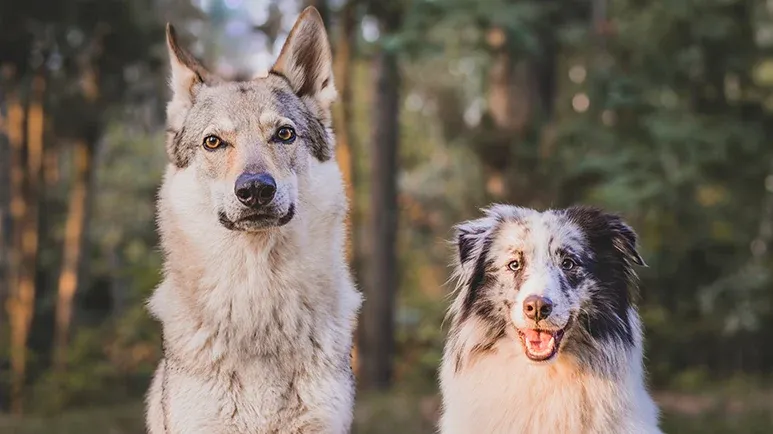Why Wild Animals Don't Have Floppy Ears and Curly Tails
Floppy ears, cute white patches, curly tails, shorter muzzles and gentle behavior - you almost never see these traits in the wild. Why are domesticated animals different? Does that mean our pets have smaller brains, too?

STORY AT-A-GLANCE
- Domestication syndrome describes a group of distinctive genetic traits seen in domesticated animals, but not in their wild counterparts
- Researchers have discovered that the process of domestication seems to lead to genetic changes that affect a group of embryonic stem cells called the neural crest
- Neural crest cells create a variety of tissue types, including pigment cells, parts of the head, and the adrenal glands; they are also indirectly involved in brain development
- The researchers believe that when certain species were bred by humans for tameness, individuals with mild neural crest deficits were selected, resulting in smaller or slow-maturing adrenal glands, as well as certain physical abnormalities
Many people have never heard the term "domestication syndrome?" If you're one of them, picture a wolf, and then picture a dog with floppy ears, a sweet little patch of white fur, and a baby (puppy) face.
According to a study published in the journal Genetics, domestication syndrome is a term Charles Darwin coined to describe his discovery that "domesticated mammals possess a distinctive and unusual suite of heritable traits not seen in their wild progenitors."1
And domestication syndrome isn't seen exclusively in mammals like dogs, rabbits, foxes, pigs, horses or sheep. It has also been observed in domesticated birds and even fish.
Domestication Leads to Genetic Changes
Scientists, including Darwin, have long been puzzled by why domesticated animals have many similar features and behaviors. These include:
- Depigmentation (white patches, brown regions)
- Floppy ears
- Smaller ears
- Shorter muzzles
- Smaller teeth
- Docile behavior
- Smaller brain or cranial capacity
- More frequent estrous cycles
- Juvenile behavior
- Curly tails
According to the authors of the Genetics study, when certain species are domesticated with the goal of taming them, it leads to genetic changes that affect a group of embryonic stem cells called the neural crest.
Neural crest cells form near the spinal cord of early vertebrate embryos. As the embryo develops, the cells travel to other locations in the body and create different tissue types, including pigment cells, parts of the head (skull, jaws, teeth, ears), and the adrenal glands, which are responsible for the fight-or-flight response. Neural crest cells are also indirectly involved in the development of the brain.
Lack of Fear of Humans Is the Result of a Cell Abnormality
According to co-author Adam Wilkins of Berlin's Humboldt University:
"When humans bred these animals for tameness, they may have inadvertently selected those with mild neural crest deficits, resulting in smaller or slow-maturing adrenal glands. So, these animals were less fearful."
The neural crest abnormalities Wilkins speaks of could also lead to physical signs of tameness – and not all of them good. For example, floppy ears are an appealing feature on dogs and rabbits, but unfortunately, they're actually the result of deformed ear cartilage. Animals with ears flopped over and hanging alongside their faces presumably don't hear as well as those with erect ears.
Domesticated animals also appear to have smaller brains than their counterparts in the wild. The decreased size of the forebrain seen in most domestic animals could be indirectly related to neural crest changes.
According to Wilkins, "Animal domestication was a crucial step in the development of human civilizations. Without these animals, it's hard to imagine that human societies would have thrived in the way they have."
What About Cats and Domestication Syndrome?
You may have noticed that in the list of domesticated mammals I mentioned above, cats aren't included. It turns out they should have been based on recent research.
A team of researchers from the University of Vienna and National Museums Scotland reported that the brains of domestic cats are smaller in size than their wild African ancestors. The study, titled "Cranial volume and palate length of cats, Felis spp., under domestication, hybridization and in wild populations," was published in 2022 in the Royal Society Open Science journal.2
The study authors measured the cranial capacity of a large number of domesticated cats to determine an average size. Then they did the same with the ancestors of modern cats, wild African cats, and observed that the brains of domesticated cats are much smaller than their ancestors.
To demonstrate that the loss of brain size was the result of domestication, the researchers measured the cranial capacity of a large number of European wildcats and a large number of hybrids. The brain size of those cats generally fell between that of the housecats and wild African cats.
As noted earlier, prior research points to a decrease in neural crest cells — brain cells involved in processing and responding to threats — as the cause of brain size decreases in domesticated animals. Pet cats, after all, face far fewer threats than their cousins in the wild. However, other scientists have offered different theories, including that it was a tradeoff between brain size and other tissues, or that it could be connected to the thyroid hormone.3
Prior research has also suggested that as cats became domesticated and faced fewer threats, their snouts should have grown shorter. Interestingly, the research team measured palate size in all the cats and found no major differences between the groups.
Domestic Animals Who Become Feral Maintain Smaller Brains
The researchers also noted that other studies have shown that if a domesticated animal becomes feral, the brain volume doesn't increase, including in animals such as Australian dingoes that became feral thousands of years ago.
According to the study authors, "… brain volume reduction due to domestication seems to be a permanent change that is not reversed by feralization, even after many generations."4











